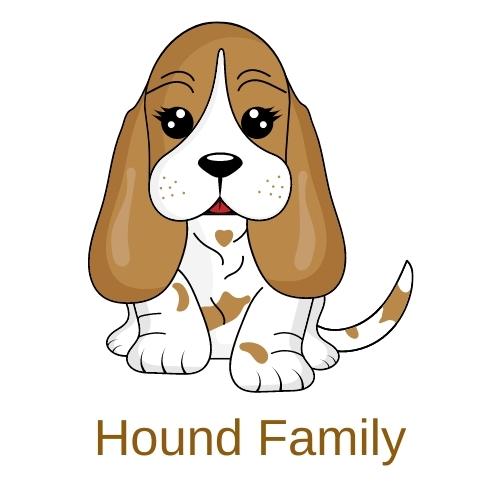
Introduction to Hound Breeds Identification
Identifying hound breeds is a fascinating journey that takes us deep into the world of dogs. This introductory section will guide you through the importance of recognizing different hound breeds and provide an overview of these amazing creatures.
- Understanding the Importance of Recognizing Hound Breeds
- Overview of Different Hound Breeds
Recognizing hound breeds is not just about knowing your dogs. It’s about understanding their unique characteristics, behaviors, and needs. Different hound breeds have different physical and behavioral traits that make them suitable for various roles and environments. For instance, some hounds are excellent hunters, while others are great companions.
Knowing the breed of a hound can help you provide the right care and training for your pet. It can also help you understand and appreciate the diversity of the canine world. Furthermore, recognizing hound breeds is crucial for dog breeders, trainers, and veterinarians in their work.
Hound breeds are incredibly diverse, each with its own unique traits and characteristics. They are generally classified into two main types: sight hounds and scent hounds.
Sight hounds, such as the Greyhound and the Saluki, are known for their speed and keen eyesight. They were traditionally used for hunting game by sight over open terrain.
Scent hounds, like the Beagle and the Bloodhound, have an exceptional sense of smell and were used for tracking game. These dogs are often slower but more persistent than sight hounds.
There are also many other hound breeds with diverse traits and characteristics. Some are small and agile, while others are large and powerful. Some are quiet and reserved, while others are energetic and playful. Each breed has its own unique charm and appeal.
In the following sections, we will delve deeper into the world of hound breeds, exploring their types, characteristics, and variations around the world. Stay tuned for a detailed guide to hound breeds, a look at hound dog varieties around the world, and key takeaways on recognizing hound breeds. We will conclude with a celebration of the diversity of hound breeds.
Types of Hound Dogs
There is a wide variety of hound dogs, each with their unique characteristics and roles. Hound dogs are typically classified into three main categories. Let’s delve into these classifications to gain a better understanding of these fascinating breeds.
Hound Breed Classification
- Scent Hounds
- Sight Hounds
- Working Hounds
Scent hounds, as the name suggests, are known for their exceptional sense of smell. They use their noses to track down a scent, making them excellent hunting dogs. Examples of scent hounds include the Beagle, Bloodhound, and Basset Hound. These dogs have long, droopy ears that help to trap the scent, and a deep, booming bark to alert their owners once they’ve found their target.
Sight hounds, on the other hand, rely on their keen eyesight to spot and chase down prey. They are typically faster and leaner than scent hounds. Sight hounds include breeds like the Greyhound, Saluki, and Whippet. These dogs are known for their speed, agility, and the ability to spot movement from a great distance.
Working hounds are a versatile group of dogs that are trained to perform specific tasks. This can range from search and rescue missions, to serving as guide dogs, to working in law enforcement. Breeds such as the Dachshund and the Rhodesian Ridgeback fall into this category. These dogs are known for their intelligence, trainability, and dedication to their work.
In conclusion, hound dogs are a diverse group with a wide range of skills and characteristics. Whether they’re using their noses, their eyes, or their brains, hounds are truly remarkable creatures.
Detailed Guide to Hound Breeds
Understanding the diversity of hound breeds can be a fascinating journey. Let’s delve into the unique characteristics that define these breeds.
Hound Breed Characteristics
There are several key characteristics that define hound breeds. These can be broadly categorized into physical attributes, behavioral traits, and common health issues.
-
Physical attributes
Hound breeds are known for their distinctive physical features. They typically have a lean, muscular body, ideal for endurance and speed. Their ears are often long and droopy, and their eyes exhibit a keen, alert expression. The coat may vary from breed to breed, ranging from short and smooth to long and silky.
-
Behavioral traits
Hounds are renowned for their exceptional hunting skills, primarily using their sense of smell or sight. They are often independent, intelligent, and have a strong instinct to chase. Despite their hunting background, many hounds are known to be gentle and friendly, making them great companions.
-
Common health issues
Like all dog breeds, hounds are susceptible to certain health issues. Common problems include hip dysplasia, eye conditions, and certain types of cancer. Some breeds may also be prone to obesity, especially if they do not get enough exercise. Regular veterinary check-ups can help detect and manage these issues early.
Understanding these characteristics can help potential owners choose a breed that fits their lifestyle and provide the best care for their hound.
Understanding Hound Breeds: Case Studies
-
Case Study 1: The Basset Hound
The Basset Hound, known for its droopy ears and keen sense of smell, is a popular hound breed. Originating from France, this breed is characterized by its short legs and long body. Basset Hounds are friendly and easygoing, making them great family pets. However, they are prone to certain health issues like obesity and ear infections due to their unique physical attributes. It’s important to ensure regular exercise and proper ear care for these lovable hounds.
-
Case Study 2: The Afghan Hound
The Afghan Hound is a breed that stands out due to its long, silky coat and elegant appearance. This breed hails from the mountains of Afghanistan and was originally used for hunting. Afghan Hounds are known for their independence and aloofness, but they also have a playful side. They require regular grooming due to their long hair, and they are generally healthy but can be prone to certain genetic conditions like hip dysplasia.
-
Case Study 3: The Dachshund
The Dachshund, often referred to as a ‘wiener dog’ due to its long body and short legs, is a breed full of personality. Originating from Germany, Dachshunds were bred for hunting badgers. They are known for their bold and tenacious nature. Despite their small size, Dachshunds are brave and can be quite stubborn. They are generally healthy, but their unique body shape can lead to spinal problems, so it’s important to avoid overfeeding and ensure they get regular exercise.
Hound Dog Varieties Around the World
As we journey through the world of hound dogs, we’ll discover a rich diversity of breeds. Each region of the world has its unique hound breeds, each with its distinct traits and characteristics. Let’s explore some of these varieties from Europe, America, and Asia.
- European Hound Breeds
- American Hound Breeds
- Asian Hound Breeds
Europe is home to a wide variety of hound breeds. For instance, the Basset Hound, a breed known for its distinctive droopy ears and keen sense of smell, originates from France. Another popular European hound is the Irish Wolfhound, one of the tallest dog breeds in the world. These dogs were initially bred for hunting wolves and are known for their strength and endurance.
When we turn our attention to America, we find breeds like the American Foxhound and the Coonhound. The American Foxhound, as the name suggests, was bred for fox hunting. This breed is known for its speed, endurance, and loud voice. On the other hand, the Coonhound, known for its unique ‘baying’ sound, was bred for tracking and treeing raccoons.
Asia, too, has its share of unique hound breeds. The Afghan Hound, originating from the mountains of Afghanistan, is one of the oldest dog breeds in the world. These dogs are known for their thick, silky hair and aloof personality. Another Asian breed is the Saluki, also known as the Persian Greyhound, which is considered one of the fastest dog breeds.
In conclusion, the world of hound dogs is as diverse as the world itself. From the Basset Hound of Europe to the American Foxhound and the Afghan Hound of Asia, each breed has its unique characteristics and history. Understanding these breeds not only enriches our knowledge of dogs but also helps us appreciate the diversity of life on our planet.
Key Takeaways: Recognizing Hound Breeds
Understanding the different hound breeds is not just for dog lovers or breeders. It’s important for everyone who interacts with these wonderful creatures. Here are the key points we’ve covered in this post:
- Importance of Breed Identification
- Recognizing Hound Breed Differences
- Practical Tips for Identifying Hound Breeds
Identifying a hound’s breed is more than just knowing what to call them. It’s about understanding their unique characteristics, behaviors, and needs. For instance, some hound breeds are known for their exceptional hunting skills, while others are famous for their keen sense of smell. By identifying their breed, you can better cater to their needs and ensure they live a healthy and happy life.
There are significant differences among hound breeds. For example, the Basset Hound has a short, stocky body and long ears, while the Greyhound is tall and slender with a streamlined body. Recognizing these differences can help you identify the breed and understand their specific needs and behaviors.
Identifying hound breeds can be challenging, but there are some practical tips that can help. Pay attention to their physical characteristics such as size, coat color, ear shape, and tail length. Also, observe their behavior. Some hounds are more energetic and playful, while others are calm and reserved. Remember, practice makes perfect. The more hounds you see and interact with, the better you’ll get at identifying their breeds.
In conclusion, recognizing hound breeds is a skill that can be developed with time and experience. It’s not just about the aesthetic appeal of the dog, but understanding their unique traits and behaviors. This knowledge can help you provide the best care for your hound and enhance your bond with them.
Conclusion: Embracing the Diversity of Hound Breeds
As we reach the end of our journey through the fascinating world of hound breeds, it’s time to reflect on what we’ve learned and the joy that comes from understanding these remarkable dogs. Let’s recap and celebrate the diversity of hound breeds.
- Recap of hound breed identification
- The joy of understanding hound breeds
We’ve explored a wide variety of hound breeds, each with its unique characteristics and traits. From the sleek and speedy Greyhound to the melodious Basset Hound, we’ve learned how to identify these breeds by their physical attributes and behaviors. We’ve discovered that hounds can be divided into two main types: sight hounds, known for their keen vision and speed, and scent hounds, recognized for their exceptional sense of smell.
Understanding the diversity of hound breeds not only enhances our appreciation for these dogs but also helps us to better care for them. Knowing a hound’s specific breed can give us insights into their needs, behaviors, and potential health issues. This knowledge brings us closer to these wonderful companions and allows us to provide them with the best possible care.
Embracing the diversity of hound breeds enriches our lives in many ways. As the famous dog trainer, Cesar Millan, once said, “Dogs are not our whole life, but they make our lives whole.” By understanding and appreciating the diversity of hound breeds, we can indeed make our lives whole.








